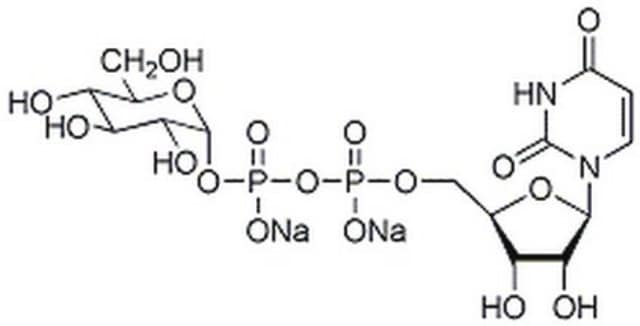94330
Uridine 5′-diphosphate disodium salt hydrate
≥96.0% (HPLC)
Synonym(s):
UDP, 5′-UDP-Na2
About This Item
Recommended Products
biological source
synthetic
Assay
≥96.0% (HPLC)
form
powder
impurities
≤15% water
storage temp.
−20°C
SMILES string
[Na+].[Na+].[H]O[H].O[C@H]1[C@@H](O)[C@@H](O[C@@H]1COP([O-])(=O)OP(O)([O-])=O)N2C=CC(=O)NC2=O
InChI
1S/C9H14N2O12P2.2Na.H2O/c12-5-1-2-11(9(15)10-5)8-7(14)6(13)4(22-8)3-21-25(19,20)23-24(16,17)18;;;/h1-2,4,6-8,13-14H,3H2,(H,19,20)(H,10,12,15)(H2,16,17,18);;;1H2/q;2*+1;/p-2/t4-,6-,7-,8-;;;/m1.../s1
InChI key
RHBXRWOXLRCWIZ-LLWADOMFSA-L
Related Categories
Application
- as a standard for quantification of metabolite levels in murine tumor interstitial fluid by liquid chromatography-mass spectrometry (LC/MS)
- as a UDP standard for nucleotide analysis by liquid chromatography-high resolution mass spectrometry (LC-HRMS)
- to treat E6.5 retina explants in vitro, to study its effect on the entry and elongation of microglial cells into the embryonic quail retina
Biochem/physiol Actions
Signal Word
Warning
Hazard Statements
Precautionary Statements
Hazard Classifications
Eye Irrit. 2 - Skin Irrit. 2 - STOT SE 3
Target Organs
Respiratory system
Storage Class Code
11 - Combustible Solids
WGK
WGK 3
Flash Point(F)
Not applicable
Flash Point(C)
Not applicable
Personal Protective Equipment
Certificates of Analysis (COA)
Search for Certificates of Analysis (COA) by entering the products Lot/Batch Number. Lot and Batch Numbers can be found on a product’s label following the words ‘Lot’ or ‘Batch’.
Already Own This Product?
Find documentation for the products that you have recently purchased in the Document Library.
Customers Also Viewed
Our team of scientists has experience in all areas of research including Life Science, Material Science, Chemical Synthesis, Chromatography, Analytical and many others.
Contact Technical Service











